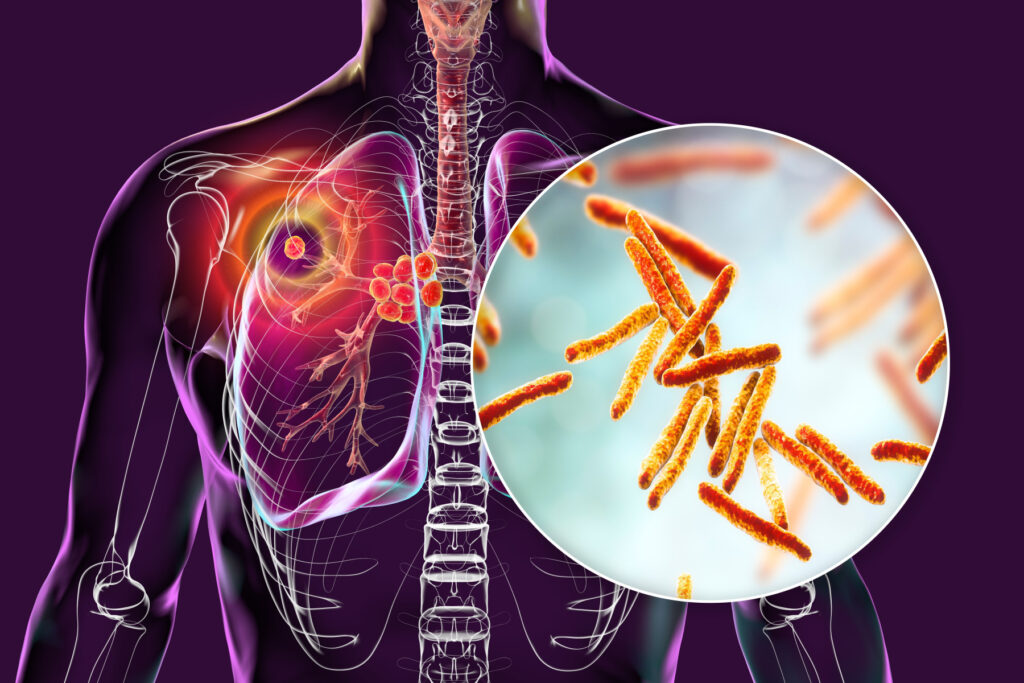Tuberculosis (TB) is a bacterial infection caused by Mycobacterium tuberculosis. It primarily affects the lungs but can spread to other parts of the body, such as the brain, spine, or kidneys. TB spreads through the air when an infected person coughs or sneezes.
Causes of Tuberculosis
TB is caused by the bacterium Mycobacterium tuberculosis, which spreads from person to person through the air. Here are the main causes and risk factors:
TB is spread through airborne droplets when an infected person:
- Coughs
- Sneezes
- Talks
- Laughs
- Sings
When someone nearby breathes in these droplets, the bacteria can enter their lungs and potentially spread to other parts of the body.
Symptoms of Tuberculosis
When TB bacteria survive and multiply in the lungs, it leads to a TB infection, which occurs in three stages. Each stage has different symptoms.
Primary TB Infection
The first stage, known as primary infection, occurs when the immune system detects and captures the bacteria. In some cases, the immune system destroys them completely, but some bacteria may survive and multiply.
Most people do not experience symptoms during this stage. However, some may develop flu-like symptoms, such as:
- Low fever
- Fatigue
- Cough
Latent TB Infection
After the primary stage, TB may enter a latent phase. The immune system contains the bacteria by forming a protective barrier around the infected lung tissue. While the bacteria remain in the body, they do not cause harm as long as the immune system keeps them in check.
There are no symptoms during latent TB infection.
Active TB Disease
Active TB develops when the immune system can no longer control the infection, allowing bacteria to spread within the lungs or to other parts of the body. This can occur soon after the primary infection or after months or years of latency.
Symptoms of active TB in the lungs typically develop gradually and worsen over time, including:
- Persistent cough
- Coughing up blood or mucus
- Chest pain
- Pain while breathing or coughing
- Fever
- Chills
- Night sweats
- Unexplained weight loss
- Loss of appetite
- Fatigue
- General feeling of unwellness
Risk factor
Some people are more vulnerable to TB infection, including:
Weak Immune System
- HIV/AIDS (HIV weakens the immune system, making it easier for TB to progress from latent to active disease)
- Diabetes
- Cancer treatments (chemotherapy, radiation therapy)
- Malnutrition
- Organ transplant patients (due to immunosuppressive drugs)
Close Contact with an Infected Person
- Living with someone who has active TB
- Healthcare workers
- People in crowded or poorly ventilated places (e.g., prisons, refugee camps, homeless shelters)
Poor Living Conditions
- Malnutrition
- Overcrowding
- Poor ventilation
Substance Use & Lifestyle Factors
- Smoking
- Excessive alcohol consumption
- Drug use
Travel & Geography
- Living in or traveling to countries with high TB rates (e.g., India, China, South Africa)
- Working in areas with high TB exposure (e.g., hospitals, mines)
Diagnosis and test
Tuberculin Skin Test (TST) / Mantoux Test
- A small amount of TB protein is injected under the skin.
- If a raised bump appears in 48-72 hours, the test may be positive.
Interferon-Gamma Release Assays (IGRAs) (Blood Test)
- Measures immune response to TB bacteria in the blood.
- Common IGRA tests: QuantiFERON-TB Gold (QFT-GIT), T-SPOT.TB
Chest X-ray / CT Scan
- Detects lung abnormalities, cavities, or nodules caused by TB.
Sputum Tests
- Sputum Smear Microscopy: Examines mucus under a microscope for TB bacteria.
- Sputum Culture: Confirms TB by growing bacteria in a lab (takes weeks).
Physiotherapy treatment
Physiotherapy is often used as supportive care for pulmonary tuberculosis (TB) to help improve lung function, reduce complications, and enhance overall recovery. It is particularly beneficial for patients with chronic lung damage or those recovering from severe TB.
Goals of Physiotherapy in TB
Improve lung function and breathing capacity
Prevent lung stiffness and airway blockage
Reduce mucus buildup and clear secretions
Enhance mobility and prevent muscle weakness
Improve overall physical strength and endurance
Treatment technique of tuberculosis
Breathing Exercises
- Diaphragmatic Breathing (Deep breathing to improve lung expansion)
- Pursed-Lip Breathing (Controls breathlessness and improves oxygen exchange)
- Segmental Breathing (Focuses on expanding affected lung areas)
Airway Clearance Techniques
- Postural Drainage (Body positioning to drain mucus from lungs)
- Percussion & Vibration (Chest clapping to loosen mucus)
- Huffing & Coughing Techniques (Helps clear secretions effectively)
Chest Expansion Exercises
- Helps maintain lung elasticity and prevents lung stiffness.
Aerobic & Endurance Training
- Walking, cycling, or light jogging to improve stamina and oxygen uptake.
Strength Training
- Light resistance exercises to prevent muscle weakness due to prolonged illness.
Posture Correction
Prevents kyphosis (hunched back) caused by long-term TB or lung damage.

